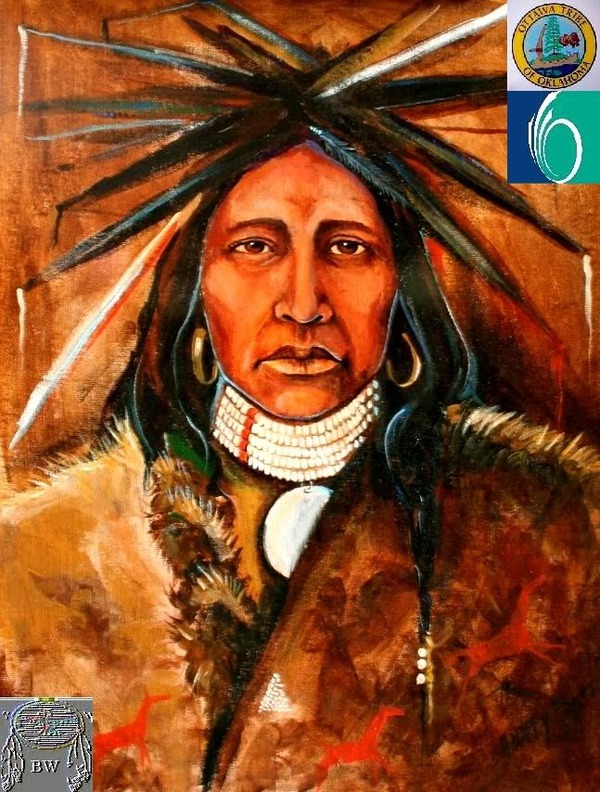
Source: Link
SAGUIMA (Saguina, Sakima, Saquima and possibly Saquin), Ottawa chief; fl. 1707?–44? Since the name is an Ottawa word for medicine man, it is impossible to be certain that all references in documents are to the same individual.
Saguima, an Ottawa chief from Michilimackinac regarded by the French as a loyal ally, attended councils at Montreal and Quebec in 1707. He and Koutaoiliboe* reported to Governor Philippe de Rigaud* de Vaudreuil on events at Detroit and Michilimackinac, claiming much of the credit for the surrender of Le Pesant*, an Ottawa chief involved in the killing of two Frenchmen. At the same time Saguima apologized to Vaudreuil for not fulfilling a promise to bring slaves for the French to give the Iroquois.
By 1712 Saguima had moved to Detroit, and he became a key figure in the early stages of the Fox war, which troubled the west until 1737. Apparently provoked by the taunts of a group of Mascoutens who were hunting close to his village, Saguima planned their destruction. In April 1712 he and a Potawatomi chief named Makisabi headed a party of a hundred warriors who attacked the Mascoutens near the St Joseph River and after a three-day battle slaughtered 200 of the survivors. The remainder of the Mascouten band fled to Detroit.
As soon as the Foxes living at Detroit learned of the massacre of their Mascouten allies, they prepared to attack the French, whom they regarded as indirectly responsible. Then Saguima, Makisabi, and 600 warriors – Ottawas, Potawatomis, Illinois, Osages, Sauks, and Menominees – arrived at Detroit in pursuit of the fleeing Mascoutens. A deep-seated resentment towards the Foxes and Mascoutens by the other tribes probably explains why Saguima was able to mobilize so large a force so quickly and why he was joined shortly by Mississaugas, Ojibwas, and Hurons.
The Detroit garrison under Jacques-Charles Renaud* Dubuisson allied itself with Saguima’s coalition and attacked the fortified Fox village, blockading it for 19 days. Before the attack Saguima’s wife and two other women from his village had been taken prisoner by the Foxes, and by a ruse the allies secured their release. Many Foxes and Mascoutens died from hunger, thirst, and disease, and terms of surrender were offered several times by the Fox chief Pemoussa* but were rejected by the allies. Finally under cover of darkness the besieged Indians escaped from their fort, but they were pursued, surrounded, and slaughtered. Dubuisson estimated their losses at a thousand men, women, and children.
After the battle Saguima abandoned his village and returned to Michilimackinac. Joseph-Jacques Marest*, the Jesuit missionary there, welcomed Saguima’s presence, believing that the Foxes and Mascoutens feared him and would be deterred from attacking the settlement.
In Marest’s opinion Saguima had more influence over the Ottawas than anyone else, but his power, like that of most Algonkian chiefs, was not great. When, for example, he requested in the summer of 1712 that the French send him one or two red blankets and a justaucorps, he specified that the gifts should not be delivered by any of his own people. They would steal them.
In 1744 there are documentary references to a “Saquin,” who was much respected by the Indians, but it seems unlikely that this was the same person.
AN, Col., C11A, 33, ff.71–76, 85–90, 160–78; 35, f.222; 81, ff.38–42. “Cadillac papers,” Michigan Pioneer Coll., XXXIII (1903), 320, 335, 347, 350, 354, 362, 365–67, 384–86, 537–57. Charlevoix, Histoire de la N.-F. (1744), IV, 95–102. “Correspondance de Vaudreuil,” APQ Rapport, 1947–48, 162–66. French regime in Wis., 1634–1727 (Thwaites), 267–82, 288–90. Y. F. Zoltvany, “New France and the west, 1701–1713,” CHR, XLVI (1965), 301–22.
Cite This Article
Donald B. Smith, “SAGUIMA (Saguina, Sakima, Saquima, Saquin),” in Dictionary of Canadian Biography, vol. 3, University of Toronto/Université Laval, 2003–, accessed December 28, 2025, https://www.biographi.ca/en/bio/saguima_3E.html.
The citation above shows the format for footnotes and endnotes according to the Chicago manual of style (16th edition). Information to be used in other citation formats:
| Permalink: | https://www.biographi.ca/en/bio/saguima_3E.html |
| Author of Article: | Donald B. Smith |
| Title of Article: | SAGUIMA (Saguina, Sakima, Saquima, Saquin) |
| Publication Name: | Dictionary of Canadian Biography, vol. 3 |
| Publisher: | University of Toronto/Université Laval |
| Year of publication: | 1974 |
| Year of revision: | 1974 |
| Access Date: | December 28, 2025 |



